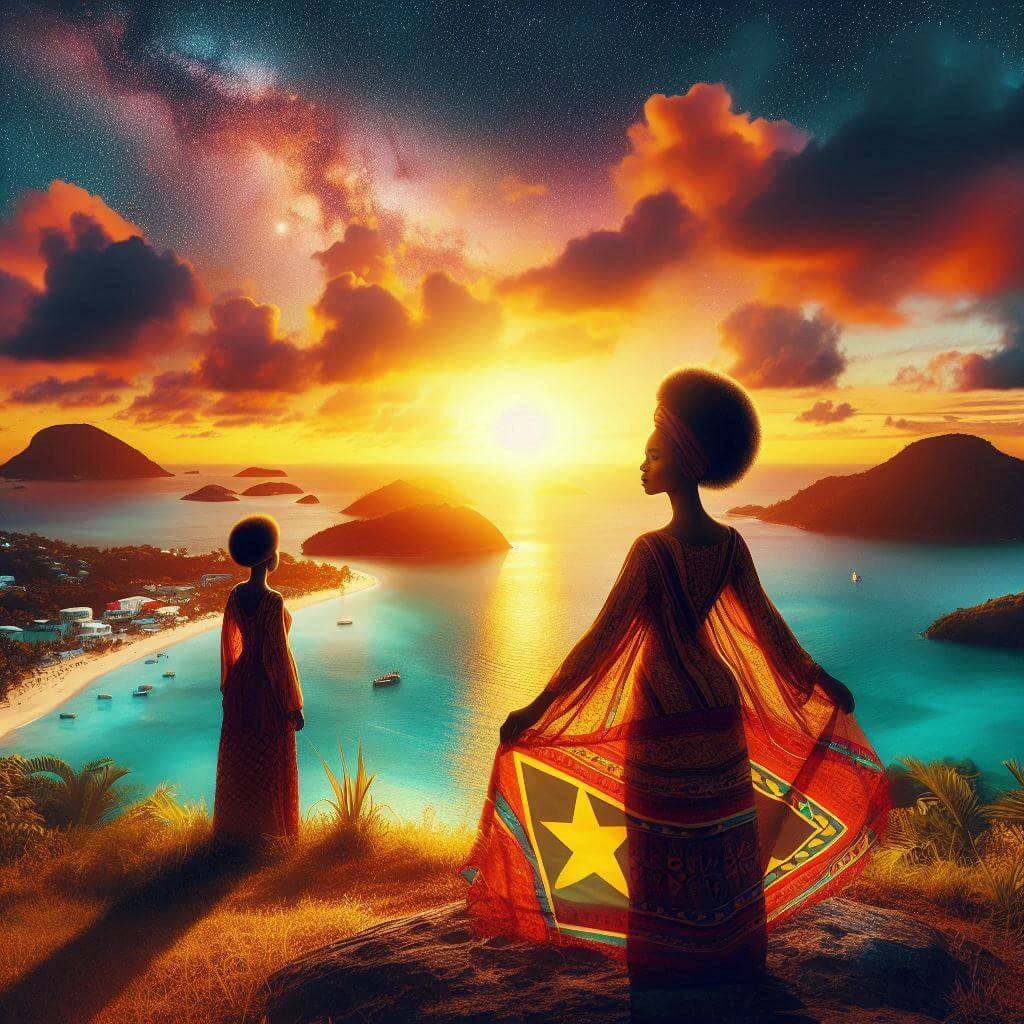La bandera de Antigua y Barbuda es una representación vibrante y simbólica de la historia, cultura y aspiraciones de la nación. Presenta un llamativo campo rojo con un triángulo isósceles invertido en su centro. Dentro de este triángulo hay tres bandas horizontales: negro en la parte superior, azul ultramar en el medio y blanco en la parte inferior. El triángulo está coronado por un medio sol que emerge de la banda azul, con siete puntos. Este diseño único encapsula la esencia de la nación de las dos islas, su belleza natural y el espíritu de su gente.
Información sobre Antigua y Barbuda
| Día Nacional de la Bandera | — |
| Estado soberano | Sí |
| Nombre oficial | Antigua y Barbuda |
| Capital | Saint John's |
| Población | 97,929 |
| Área | 442 km² |
| Moneda | Dólar del Caribe Oriental (XCD) |
| Idioma | Inglés |
| Continente | América del Norte |
| Región | Caribe |
| Subregión | — |
| Fronteras | — |
| Zona horaria | Hora Estándar del Atlántico (AST) UTC-4 |
| Código de llamada | +1-268 |
| Dominio de nivel superior | .ag |
Historia y evolución de la bandera de Antigua y Barbuda
 La bandera actual de Antigua y Barbuda fue adoptada oficialmente el 27 de febrero de 1967, coincidiendo con el logro del estatus de estado asociado dentro de la Commonwealth británica. Fue diseñada por Sir Reginald Samuel, un artista y maestro local, quien ganó un concurso nacional para crear una bandera que simbolizara la identidad y aspiraciones de la nación.
La bandera actual de Antigua y Barbuda fue adoptada oficialmente el 27 de febrero de 1967, coincidiendo con el logro del estatus de estado asociado dentro de la Commonwealth británica. Fue diseñada por Sir Reginald Samuel, un artista y maestro local, quien ganó un concurso nacional para crear una bandera que simbolizara la identidad y aspiraciones de la nación.
Antes de 1967, Antigua y Barbuda, como colonia británica, usaba el Pabellón Azul Británico desfigurado con la insignia colonial de Antigua. Esta bandera anterior presentaba una escena de paisaje con un molino de azúcar, simbolizando la economía colonial de las islas. La transición a la bandera actual marcó un cambio significativo, alejándose del simbolismo colonial hacia un diseño que celebraba la belleza natural de las islas y las esperanzas de su gente.
Aunque la bandera fue adoptada en 1967, continuó representando a Antigua y Barbuda hasta su plena independencia del Reino Unido el 1 de noviembre de 1981. La decisión de mantener la bandera después de la independencia refleja la naturaleza perdurable de su simbolismo y su fuerte resonancia con el pueblo de Antigua y Barbuda.
Simbolismo y diseño de la bandera de Antigua y Barbuda
Cada elemento de la bandera de Antigua y Barbuda está impregnado de un profundo simbolismo, reflejando la geografía, historia y aspiraciones de la nación:
- El campo rojo simboliza la energía y dinamismo del pueblo. También representa la sangre derramada por los antepasados en su lucha contra la esclavitud y el colonialismo.
- El triángulo invertido tiene múltiples significados:
- Representa las numerosas bahías y puertos naturales de las islas.
- Su forma imita la letra "A", que significa Antigua.
- El triángulo invertido también se ve como un símbolo de igualdad y estabilidad.
- La banda negra en la parte superior del triángulo simboliza la herencia africana de la mayoría de la población y el suelo rico y fértil de las islas.
- La banda azul en el medio representa la esperanza y el Mar Caribe que rodea las islas.
- La banda blanca en la parte inferior simboliza las playas de arena que hacen famosa a Antigua y Barbuda como destino turístico. También representa la pureza y claridad de propósito.
- El sol naciente con siete puntos simboliza:
- El amanecer de una nueva era para la nación.
- Los siete puntos representan las seis parroquias de Antigua y Barbuda como la séptima.
- También alude al apodo del país como la "Tierra de 365 playas" - una para cada día del año.
Uso y significado de la bandera de Antigua y Barbuda
 La bandera de Antigua y Barbuda sirve como un poderoso símbolo de identidad y orgullo nacional. Se exhibe prominentemente en edificios gubernamentales, escuelas e instituciones públicas en ambas islas. Durante las fiestas nacionales, como el Día de la Independencia (1 de noviembre) y el Día de los Héroes Nacionales (9 de diciembre), la bandera ocupa un lugar central en las celebraciones, desfiles y ceremonias oficiales.
La bandera de Antigua y Barbuda sirve como un poderoso símbolo de identidad y orgullo nacional. Se exhibe prominentemente en edificios gubernamentales, escuelas e instituciones públicas en ambas islas. Durante las fiestas nacionales, como el Día de la Independencia (1 de noviembre) y el Día de los Héroes Nacionales (9 de diciembre), la bandera ocupa un lugar central en las celebraciones, desfiles y ceremonias oficiales.
En contextos internacionales, la bandera de Antigua y Barbuda representa a la nación en eventos diplomáticos, reuniones de las Naciones Unidas y competiciones deportivas. Es una fuente de orgullo para los atletas de Antigua y Barbuda que compiten en eventos como los Juegos Olímpicos y la Copa Mundial de Críquet, donde simboliza su identidad nacional en el escenario global.
La bandera también juega un papel significativo en la industria turística del país, a menudo presentada en materiales promocionales como un símbolo de la cálida hospitalidad y la impresionante belleza natural de la nación. Muchos visitantes a Antigua y Barbuda compran versiones en miniatura de la bandera como recuerdos, difundiendo aún más la conciencia sobre el patrimonio cultural distintivo del país.
Datos interesantes sobre la bandera de Antigua y Barbuda
- El diseñador de la bandera, Sir Reginald Samuel, fue galardonado con la Gran Cruz de la Orden del Mérito Príncipe (GCPM) por su contribución a los símbolos nacionales de Antigua y Barbuda.
- El diseño único de la bandera, particularmente el triángulo invertido, la hace fácilmente reconocible entre las banderas del mundo.
- El sol de siete puntas en la bandera a veces se conoce como la "Estrella de Antigua" y se ha convertido en un símbolo popular en el arte y la cultura local.
- El tono exacto de azul utilizado en la bandera es ultramar, elegido por su vibrancia y su representación del Mar Caribe.
- En la cultura de Antigua y Barbuda, el sol naciente en la bandera a menudo se interpreta como un símbolo de resiliencia y la capacidad de superar desafíos.
- La bandera se presenta prominentemente en el escudo de armas del país, donde es sostenida por dos ciervos, simbolizando la fauna de las islas.





